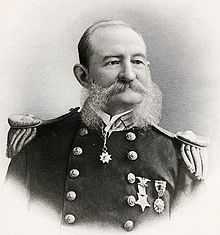Zera Luther Tanner
| Zera Luther Tanner | |
|---|---|
 Captain Zera L. Tanner | |
| Born |
December 5, 1835 Warsaw, New York |
| Died |
December 16, 1906 (aged 71) Washington, D.C. |
| Buried at | Arlington National Cemetery |
| Allegiance |
|
| Service/branch | United States Navy |
| Years of service | 1868–1897 |
| Rank |
|
| Commands held |
USFC Fish Hawk USFC Albatross |
Zera Luther Tanner (December 5, 1835 – December 16, 1906), sometimes spelled Zero,[1] was an American naval officer, inventor, and oceanographer. Tanner invented a depth sounding system, wrote several books on hydrography and retired a commander of the United States Navy in 1897.[2]
Career
Zera Tanner was born in Warsaw, New York in 1835, the son of Zerah and Ruth (Foster) Tanner. The elder Tanner died when his son was one year old, so the younger Tanner worked in family farms until his late teens, when he apprenticed to a mechanic. Tanner traveled by ship to Great Britain in 1855, and because of ill health chose to take a longer voyage from Liverpool to Bombay, India aboard SS Culloden in 1856.[3] After two round trips, one as third officer, Tanner chose sailing for his profession.[4]
Returning to the United States, after Tanner served about American merchantmen, he eventually assisted several seaborne troop movements in the Gulf of Mexico. Tanner chose to join government service and was appointed acting ensign of the Union Navy in the summer of 1862. Tanner served upon the bark USS Midnight and the supply steamer USS Rhode Island during the American Civil War. When Rhode Island captured a British blockade runner in December 1864, Tanner was put in charge of the prize crew. During the Second Battle of Fort Fisher, Tanner commanded the boats from his vessel landing Union ground forces.[1]
Tanner entered the United States Navy in 1868, coming over from the deactivated volunteer services.[2] Until his retirement in 1897, Tanner served the navy in hydrographic survey and dredging commands, often in conjunction with the United States Commission of Fish and Fisheries, generally known as the United States Fish Commission.[3] Tanner partially designed and oversaw the construction of two ships for the commission. USFC Fish Hawk, in service from 1880 to 1926 and the first large vessel ever built expressly for the promotion of fisheries, was a smaller vessel designed for coastal waters and was primarily used as a mobile fish hatchery although she also conducted fisheries research, while USFC Albatross, which served as a fisheries research ship from 1882 to 1921 except for brief periods in U.S. Navy service in 1898 and from 1917 to 1919, was the first full-sized vessel primarily designed for marine research. Tanner was the first commanding officer of Fish Hawk, and he commanded Albatross for many years, including transporting famed naturalist Alexander Emanuel Agassiz on an 1891 voyage to the Galapagos Islands.
Tanner developed an improved method of depth sounding, using instruments of his own design. He patented his system in 1899 as the Tanner navigational sounding apparatus.[5]
Selected works
- Deep-sea exploration: a general description of the steamer Albatross, her appliances and methods
Legacy
Tanner died in Washington, D.C. in late 1906 and was buried with military honors at Arlington National Cemetery.[2]
Two U.S. Navy ships have been named after Tanner. After World War II, USS Pamina (AKA-34), an attack cargo ship with service in the Okinawa campaign was re-purposed for oceanographic survey work and renamed USS Tanner (AGS-15). Tanner spent her career mapping significant coastline areas and was retired in 1969.[1] In 1990, USNS Tanner (T-AGS-40) was built for the U.S. Navy as a fast oceanographic research vessel. Now named TS State of Maine, she serves as the training ship of the Maine Maritime Academy.[6]
Gallery
References
- ↑ 1.0 1.1 1.2 Mooney, James L. (December 31, 1981). Dictionary of American Naval Fighting Ships. Government Printing Office. p. 42. Retrieved 29 July 2012.
- ↑ 2.0 2.1 2.2 "Capt. Z.L. Tanner, U.S.N.". New York Times (New York Times Company). December 17, 1906. Retrieved 29 July 2012.
- ↑ 3.0 3.1 Gates, Merrill E. (1906). Cover of: Men of mark in America by Merrill Edwards Gates Manage Covers Men of mark in America ideals of American life told in biographies of eminent living Americans II. Washington, D.C.: Men of Mark Publishing Company. pp. 332–335. Retrieved July 29, 2012.
- ↑ The National cyclopaedia of American biography VIII. James T. White & Co. 1898. pp. 384–385. Retrieved 29 July 2012.
- ↑ Tanner, Zera Luther (1903). A general description of the Tanner navigational sounding apparatus with directions for use. The Law Reporter Company. p. 21.
- ↑ "State of Maine history". Archived from the original on August 15, 2010. Retrieved 29 July 2012.
